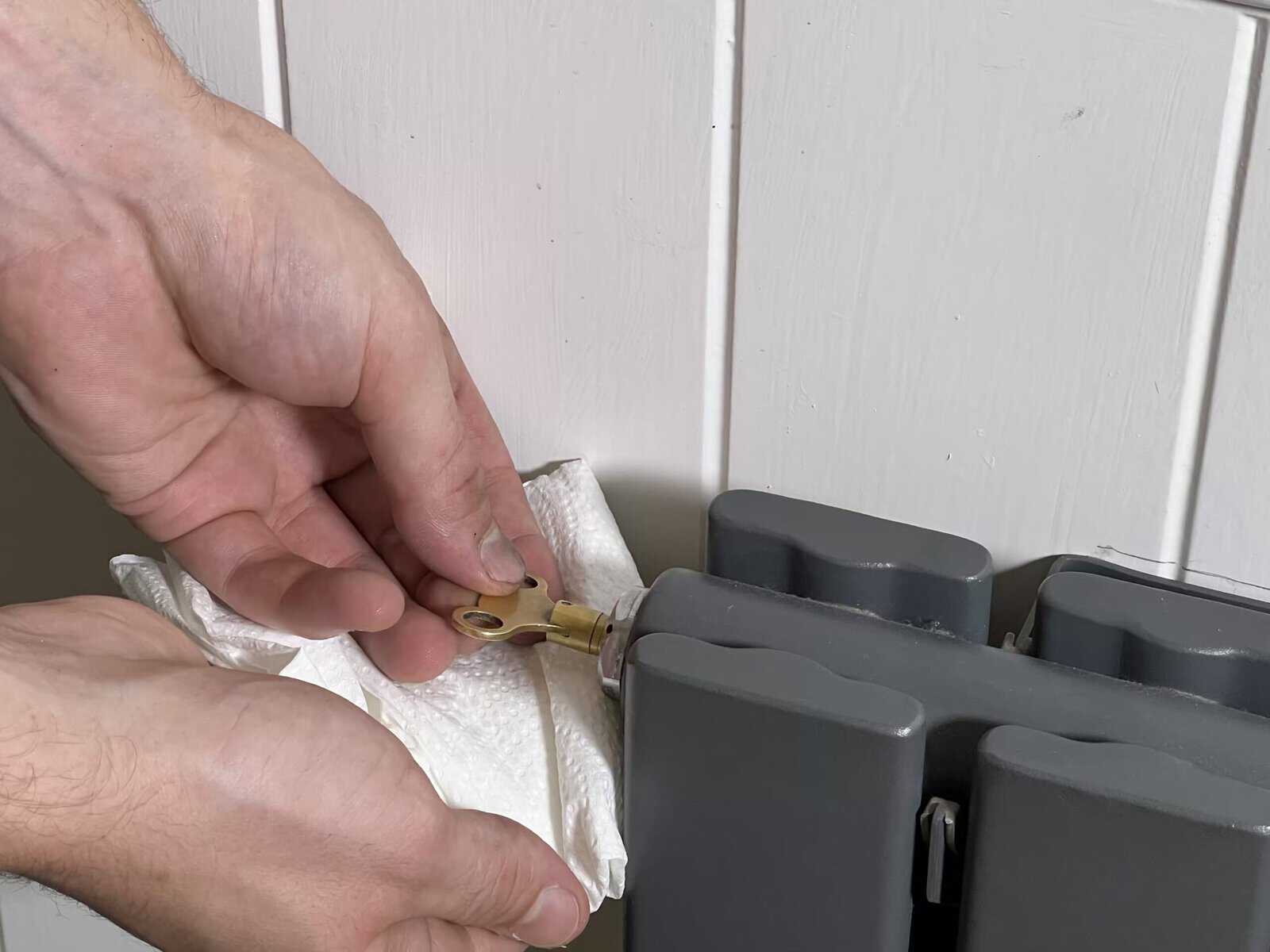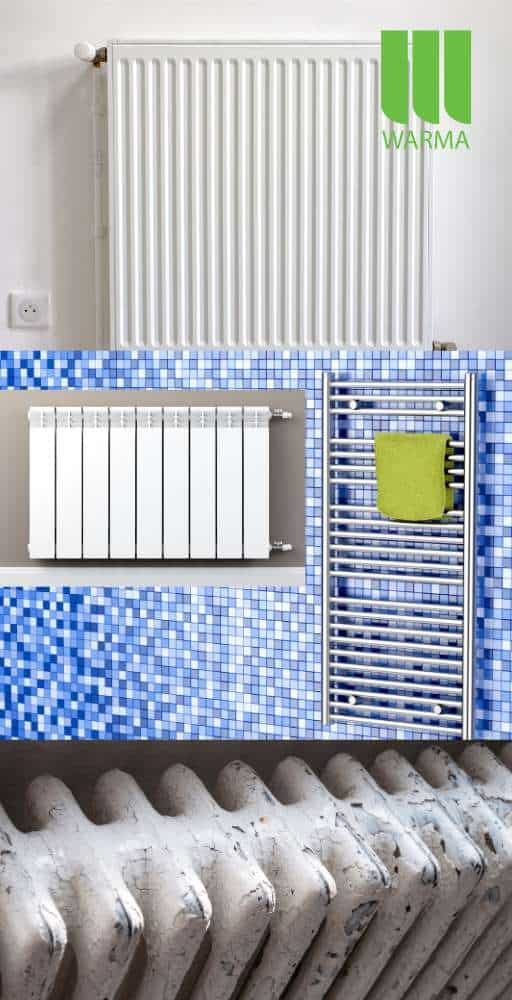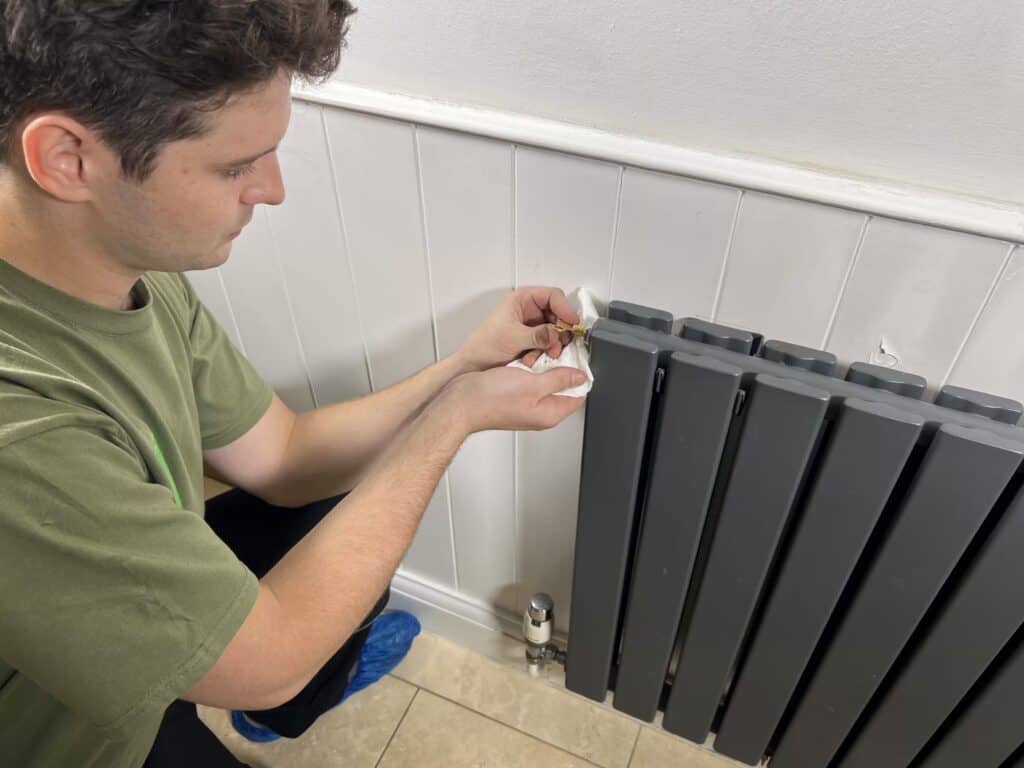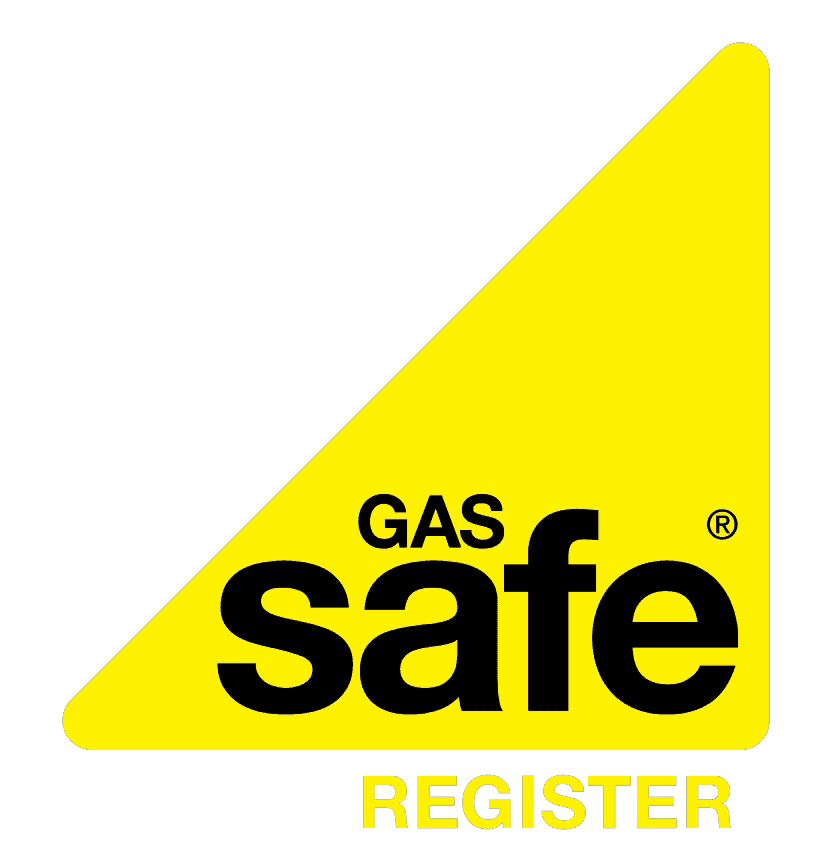It can feel daunting to do your own central heating adjustments but with the help of this article you should have the know-how and a little bit more confidence to bleed a radiator.
What is it? And why should I bleed my radiators?
Your heating system should ideally be filled with water but unfortunately air finds its way into your system through various paths. Air gets trapped in the system and usually collects in radiators or at high points in the pipework. The pumps used to circulate the water around the system are designed only to pump water, when they encounter air, circulation stops and sometimes the pump is damaged beyond repair.
However, oftentimes this won’t occur, there will simply be a build up of air in the radiators causing them to be cold in the area where air has accumulated. Bleeding the radiators by opening the radiator vent is the best way to counteract this air accumulation.

Common Signs Your Radiator Needs Bleeding
If your home isn’t heating up as efficiently as it should, it might be time to bleed your radiator. When air gets trapped inside a radiator, it prevents hot water from circulating properly, causing cold spots and reducing overall heating efficiency. Recognising the signs that your radiator needs bleeding can help you fix the issue quickly and improve your home’s warmth.
Key Signs Your Radiator Needs Bleeding:
- Cold Spots at the Top: One of the most obvious signs that your radiator needs bleeding is if the top of the radiator is cold while the bottom remains warm. This happens because air gets trapped at the top, preventing the hot water from reaching that area.
- Gurgling or Hissing Noises: Unusual sounds such as gurgling, hissing, or bubbling coming from your radiators are another indication that there’s air trapped in the system. This air can stop your radiators from heating up properly, so bleeding the radiator will remove the trapped air and solve the problem.
- Radiator Takes Too Long to Heat Up: If your radiator is slow to warm up or doesn’t reach the desired temperature, trapped air may be the culprit. Bleeding the radiator allows the air to escape, enabling the hot water to flow freely and heat your room more effectively.
- Lower Overall Heating Efficiency: If you’ve noticed that your central heating system isn’t as efficient as it used to be and your energy bills are creeping up, air in the radiators might be to blame. Bleeding your radiators can help restore efficiency, ensuring your home stays warm without driving up your heating costs.
Why It’s Important to Bleed a Radiator
Not addressing trapped air in your radiator can reduce your heating system’s effectiveness, forcing your boiler to work harder, which can increase your energy bills. Regularly checking your radiators for these signs and bleeding them when necessary can improve heating performance and extend the life of your system.
How Often Should You Bleed Your Radiator?
Regularly maintaining your heating system by bleeding your radiators can make a big difference in your home’s comfort and energy efficiency. Knowing how often to bleed your radiator helps ensure your central heating system operates smoothly, without trapped air causing cold spots or reducing the heat output.
How Often Should You Bleed Radiators?
- At the Start of the Heating Season: It’s recommended to bleed your radiators at least once a year, typically at the start of the colder months. As you turn your heating back on after a period of inactivity, air can become trapped in the system, reducing the radiator’s efficiency. Bleeding radiators at the beginning of autumn ensures that your home stays warm and your heating system runs optimally.
- If You Notice Cold Spots: If you start to feel cold spots at the top of your radiators, it’s a clear sign that air is trapped inside. This is a good indication that your radiator needs bleeding immediately to restore full heating capacity.
- After Boiler Maintenance or System Repairs: If you’ve recently had your boiler serviced or repairs done to your heating system, air can often enter the radiators. In such cases, it’s advisable to bleed the radiators to prevent performance issues and ensure the system runs efficiently.
- When Radiators Make Unusual Noises: Gurgling, hissing, or bubbling sounds coming from your radiators are typical signs that air is trapped in the system. Even if you’ve recently bled them, these noises indicate that you may need to bleed the radiators again.
Why Regular Bleeding Improves Efficiency
Bleeding your radiators frequently prevents trapped air from disrupting the flow of hot water. This simple maintenance task not only improves your radiator’s ability to heat your home evenly but also boosts energy efficiency, helping you save on heating bills. Ignoring air buildup could result in your boiler working harder than necessary, leading to higher energy costs and potential system strain.
What Happens If You Don’t Bleed Your Radiator?
If you don’t bleed your radiators regularly, you may notice a decline in heating performance, with rooms taking longer to warm up. Over time, trapped air can cause long-term damage to your heating system, reducing its lifespan and making your home less energy-efficient.
Can You Bleed All Types of Radiators?
While many homeowners are familiar with the process to bleed a radiator, not all radiators require bleeding, and some may need a different approach. Knowing which types of radiators can be bled and how to handle them is key to maintaining your heating system.
Which Radiators Can Be Bled?:
- Standard Hot Water Radiators: Most central heating systems in the UK use hot water radiators, which often develop air pockets over time. These types of radiators can easily be bled using a radiator key to release trapped air and restore full heating efficiency.
- Towel Radiators: Towel radiators, commonly found in bathrooms, can also develop air pockets. You can use the same method to bleed a towel radiator, ensuring it heats up properly and dries your towels efficiently.
- Electric Radiators: Electric radiators are different from traditional water-based systems, as they do not contain water. As a result, you don’t need to bleed electric radiators. If an electric radiator isn’t heating up properly, the issue could be electrical or internal, and you should consult a professional.
- Designer or Vertical Radiators: Modern designer radiators or vertical radiators, which are gaining popularity in homes, can often be bled just like standard radiators. However, due to their unique shapes, make sure to follow the manufacturer’s instructions to bleed a radiator of this type correctly.
- Old Cast-Iron Radiators: These classic radiators can be bled as well, but the bleed valve may differ slightly from modern radiators. Be cautious when handling older radiators, as they may be more fragile or prone to leaks.

When Not to Bleed a Radiator:
If you have electric radiators or underfloor heating, bleeding isn’t required. Instead, consult a heating expert if you notice any performance issues. Understanding which radiators need bleeding and how to do it properly helps you maintain a warm and energy-efficient home.
Safety Tips When You Bleed a Radiator
When it comes to maintaining your heating system, safety should always be a priority. If you need to bleed a radiator, there are a few safety precautions to keep in mind to avoid accidents and ensure the job is done correctly.
Key Safety Tips When You’re Bleeding Your Radiator:
- Turn Off the Heating: Always make sure to turn off your heating system before you begin to bleed your radiator. This prevents hot water from circulating, reducing the risk of burns or injury from hot water spurting out when the valve is opened.
- Allow Radiators to Cool Down: Even after the heating is switched off, radiators can remain hot for a while. Let them cool down completely before you bleed a radiator to avoid burns from hot surfaces or water.
- Use a Proper Radiator Key: It’s essential to use a proper radiator key or screwdriver to carefully turn the bleed valve. Avoid using makeshift tools, as they can damage the valve or cause it to snap.
- Prepare for Water: Have a cloth and a small bowl or container ready to catch any water that might escape when you bleed the radiator. This prevents spills and keeps the area clean.
- Check Boiler Pressure After Bleeding: After you bleed any radiator, the boiler pressure can drop. Be sure to check the pressure gauge and, if necessary, top up the pressure to the recommended level for optimal heating performance.
By following these safety steps, you can safely bleed a radiator without damaging your heating system or risking injury.
How do I Bleed a Radiator, Step-By-Step?
Tools required: A radiator key or a flathead screwdriver, old rag or tissue paper.
- Identify the problem radiator by turning on your heating and feeling for cold spots. Remember to be mindful that air will rise to the top of the radiators and will distribute itself evenly.
- Open the radiator vent by inserting the flathead screwdriver into the slot on the vent screw and rotate counterclockwise SLOWLY and listen for the hissing sound of air escaping.
- When the air has drained, the water from the heating system will begin bubbling through the vent. At this point, the tissue that you have been holding between the vent and your lovely painted wall will protect it from the dirty, black water of your heating system. Now close the vent and tighten until hand tight only.
- Repeat on all radiators in your home.
Top tip: start with the radiator farthest from your boiler as it is likely to have accumulated the most air.
What to Do After You Bleed a Radiator
Once you’ve completed the process to bleed a radiator, it’s important to take a few additional steps to ensure your heating system is working efficiently. Following these post-bleeding actions will help maintain your system’s performance.
Steps to Take After You Bleed a Radiator:
- Check the Radiator Temperature: After you’ve bled the radiator, turn the heating system back on and allow the radiator to warm up. Check to make sure it’s heating evenly from top to bottom. If there are still cold spots, you may need to bleed it again or investigate other issues such as sludge buildup.
- Monitor Boiler Pressure: Bleeding a radiator can cause a drop in your boiler pressure, which can affect the overall efficiency of your heating system. Once you’ve finished, check the boiler’s pressure gauge. If it’s too low, top it up using the filling loop to restore the correct pressure.
- Look for Leaks: After you bleed a radiator, inspect the valve for any signs of leaking. If there’s a persistent leak, tighten the valve gently or, if necessary, call a professional to fix the issue.
- Test the Whole System: It’s a good idea to run your heating system for a while and check all your radiators after bleeding one. This ensures there’s no air left trapped in other radiators, which could impact the overall heating efficiency of your home.
By following these steps, you can ensure that your heating system runs smoothly after you bleed a radiator and that your home stays warm and comfortable.
What If Bleeding the Radiator Doesn’t Fix the Problem?
In most cases, learning how to bleed a radiator is a simple and effective way to resolve issues like cold spots or gurgling noises. However, if you’ve followed the steps to bleed a radiator and it still isn’t heating properly, there may be other underlying issues with your heating system.
Common Issues After Bleeding a Radiator:
- Sludge Build-Up: If your radiator remains cold at the bottom even after bleeding, it could be a sign of sludge or debris buildup inside. Over time, sediment can accumulate in radiators, reducing efficiency and blocking hot water from circulating properly. A power flush may be needed to clear the system.
- Faulty Valves: Sometimes, the issue lies with a faulty valve rather than trapped air. If the radiator bleed valve or thermostatic radiator valve (TRV) isn’t working correctly, it could prevent the radiator from heating up fully, even after you’ve bled it.
- Boiler Pressure Issues: Bleeding radiators can cause the boiler pressure to drop. If the boiler pressure is too low, it can prevent hot water from circulating through the system effectively. Check your boiler’s pressure gauge and, if necessary, top it up to restore the correct pressure.
- Airlocks in the System: Occasionally, bleeding one radiator may cause air to become trapped elsewhere in the system, leading to an airlock. This can stop hot water from reaching certain radiators. In this case, you may need to bleed multiple radiators or consult a professional to resolve the airlock.
- System Imbalance: If only some radiators in your home are affected, it could be a sign of an imbalanced heating system. Radiators that are far from the boiler may struggle to receive enough hot water, especially if the system hasn’t been balanced recently.
When to Call in the Experts
If you’ve tried to bleed a radiator and it’s still not heating correctly, it’s likely time to call a professional for a more thorough inspection. At Warma Heating and Plumbing, we specialise in diagnosing and resolving all types of heating system problems, from blocked radiators to boiler issues.
Our experienced team can help identify the root cause of the problem, whether it’s trapped air, sludge buildup, or a faulty valve, and provide effective solutions to restore your home’s warmth. Don’t let radiator problems go unresolved – contact Warma Heating and Plumbing today for expert assistance with all your heating and plumbing needs.
If everything is working as it should, your radiators should now be heating up evenly and efficiently. With your home feeling warm and cozy again, it’s time to relax! Grab a blanket, cuddle up on the sofa, and enjoy the comfort of your newly warm home.








1 thought on “How to bleed a radiator”